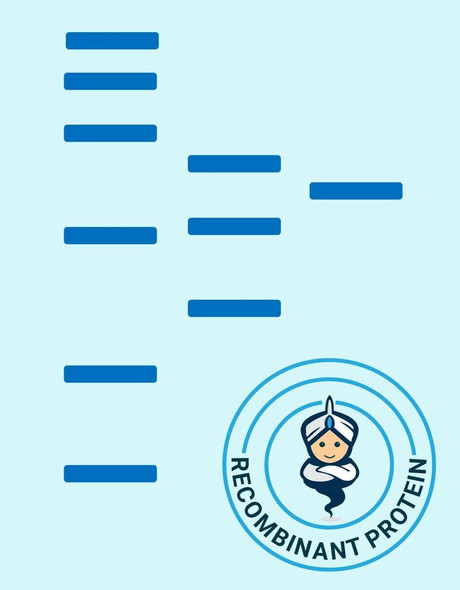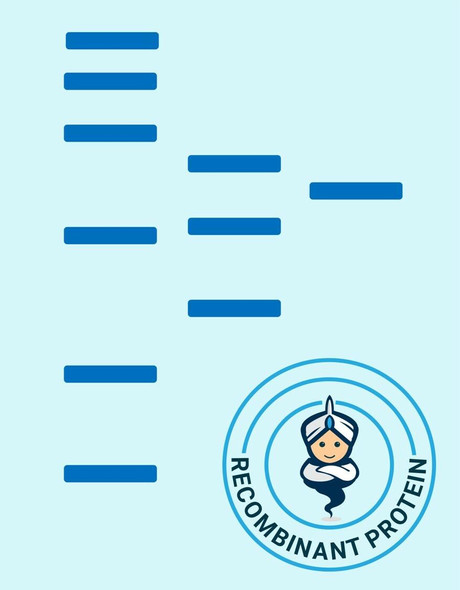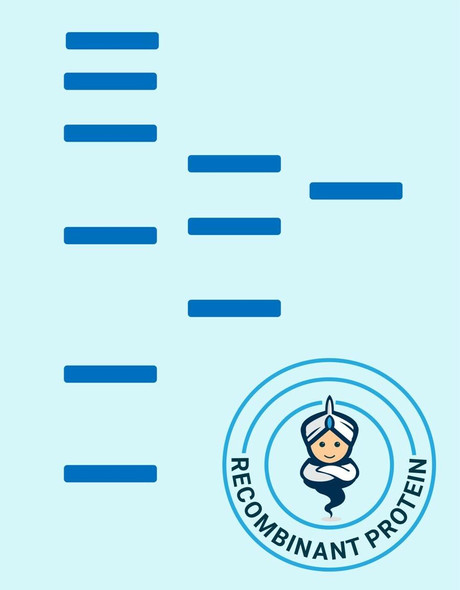Human I TAC Recombinant Protein (RPPB1176)
- SKU:
- RPPB1176
- Product type:
- Recombinant Protein
- Size:
- 20ug
- Species:
- Human
- Target:
- I TAC
- Synonyms:
- Small inducible cytokine B11
- CXCL11
- Interferon-inducible T-cell alpha chemoattractant
- I-TAC
- Source:
- Escherichia Coli
- Uniprot:
- O14625
Description
| Product Name: | Human I TAC Recombinant Protein |
| Product Code: | RPPB1176 |
| Size: | 20µg |
| Species: | Human |
| Target: | I TAC |
| Synonyms: | Small inducible cytokine B11, CXCL11, Interferon-inducible T-cell alpha chemoattractant, I-TAC, Interferon-gamma-inducible protein 9, IP-9, H174, Beta-R1, chemokine (C-X-C motif) ligand 11, IP9, b-R1, SCYB11, SCYB9B, MGC102770. |
| Source: | Escherichia Coli |
| Physical Appearance: | Sterile filtered colorless solution. |
| Formulation: | The I-TAC solution (1mg/ml) contains 10mM sodium citrate(pH 3.5), 20% glycerol and 2mM DTT. |
| Stability: | Store at 4°C if entire vial will be used within 2-4 weeks. Store, frozen at -20°C for longer periods of time. For long term storage it is recommended to add a carrier protein (0.1% HSA or BSA).Avoid multiple freeze-thaw cycles. |
| Purity: | Greater than 90.0% as determined by SDS-PAGE. |
| Amino Acid Sequence: | MGSSHHHHHH SSGLVPRGSH MFPMFKRGRC LCIGPGVKAV KVADIEKASI MYPSNNCDKI EVIITLKENK GQRCLNPKSK QARLIIKKVE RKNF |
Chemokine (C-X-C motif) ligand 11 (CXCL11) is a small cytokine belonging to the CXC chemokine family that is also called Interferon-inducible T-cell alpha chemoattractant (I-TAC) and Interferon-gamma-inducible protein 9 (IP-9). It is highly expressed in peripheral blood leukocytes, pancreas and liver, with moderate levels in thymus, spleen and lung and low expression levels were in small intestine, placenta and prostate. Gene expression of CXCL11 is strongly induced by IFN-g and IFN-b, and weakly induced by IFN-a. This chemokine elicits its effects on its target cells by interacting with the cell surface chemokine receptor CXCR3, with a higher affinity than do the other ligands for this receptor, CXCL9 and CXCL10. CXCL11 is chemotactic for activated T cells. Its gene is located on human chromosome 4 along with many other members of the CXC chemokine family.
I-TAC (CXCL11) Human Recombinant produced in E.coli is a single, non-glycosylated polypeptide chain containing 94 amino acids (22-94) and having a molecular mass of 10.6kDa.I-TAC is fused to a 21 amino acid His-tag at N-terminus & purified by proprietary chromatographic techniques.
| UniProt Protein Function: | CXCL11: Chemotactic for interleukin-activated T-cells but not unstimulated T-cells, neutrophils or monocytes. Induces calcium release in activated T-cells. Binds to CXCR3. May play an important role in CNS diseases which involve T-cell recruitment. May play a role in skin immune responses. Belongs to the intercrine alpha (chemokine CxC) family. |
| UniProt Protein Details: | Protein type:Motility/polarity/chemotaxis; Chemokine; Secreted; Secreted, signal peptide Chromosomal Location of Human Ortholog: 4q21.2 Cellular Component: extracellular space; extracellular region Molecular Function:heparin binding; protein binding; CXCR3 chemokine receptor binding; chemokine activity Biological Process: G-protein coupled receptor protein signaling pathway; cell-cell signaling; immune response; positive regulation of leukocyte chemotaxis; response to lipopolysaccharide; positive regulation of release of sequestered calcium ion into cytosol; positive regulation of cAMP metabolic process; signal transduction; chemotaxis; inflammatory response; regulation of cell proliferation |
| NCBI Summary: | Chemokines are a group of small (approximately 8 to 14 kD), mostly basic, structurally related molecules that regulate cell trafficking of various types of leukocytes through interactions with a subset of 7-transmembrane, G protein-coupled receptors. Chemokines also play fundamental roles in the development, homeostasis, and function of the immune system, and they have effects on cells of the central nervous system as well as on endothelial cells involved in angiogenesis or angiostasis. Chemokines are divided into 2 major subfamilies, CXC and CC. This antimicrobial gene is a CXC member of the chemokine superfamily. Its encoded protein induces a chemotactic response in activated T-cells and is the dominant ligand for CXC receptor-3. The gene encoding this protein contains 4 exons and at least three polyadenylation signals which might reflect cell-specific regulation of expression. IFN-gamma is a potent inducer of transcription of this gene. Two transcript variants encoding different isoforms have been found for this gene. [provided by RefSeq, Oct 2014] |
| UniProt Code: | O14625 |
| NCBI GenInfo Identifier: | 7674360 |
| NCBI Gene ID: | 6373 |
| NCBI Accession: | O14625.1 |
| UniProt Related Accession: | O14625 |
| Molecular Weight: | |
| NCBI Full Name: | C-X-C motif chemokine 11 |
| NCBI Synonym Full Names: | C-X-C motif chemokine ligand 11 |
| NCBI Official Symbol: | CXCL11 |
| NCBI Official Synonym Symbols: | IP9; H174; IP-9; b-R1; I-TAC; SCYB11; SCYB9B |
| NCBI Protein Information: | C-X-C motif chemokine 11 |
| UniProt Protein Name: | C-X-C motif chemokine 11 |
| UniProt Synonym Protein Names: | Beta-R1; H174; Interferon gamma-inducible protein 9; IP-9; Interferon-inducible T-cell alpha chemoattractant; I-TAC; Small-inducible cytokine B11 |
| UniProt Gene Name: | CXCL11 |
| UniProt Entry Name: | CXL11_HUMAN |










